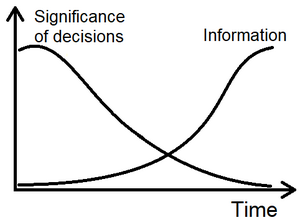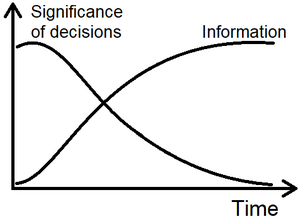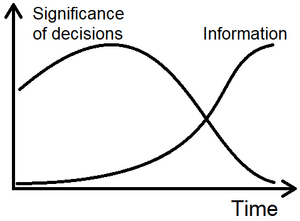The paradox of project planning from an uncertainty perspective
| Line 1: | Line 1: | ||
''Developed by Freja Ejdrup Andersen, February 2022 '' | ''Developed by Freja Ejdrup Andersen, February 2022 '' | ||
| − | One of the most difficult things to plan in a project is the uncertainty and the risk associated with it. When planning a project, decisions are often made in the early stages where there is a lot of epistemic uncertainty [[Epistemic vs. Aleatory uncertainty]] | + | One of the most difficult things to plan in a project is the uncertainty and the risk associated with it. When planning a project, decisions are often made in the early stages where there is a lot of epistemic uncertainty (see [[Epistemic vs. Aleatory uncertainty]]). To have a project run smoothly and keep the budget and overall deadlines in check, important decisions need to be made early in order to define a clear schedule. This can however not be made without knowledge, which is sparse in the early stages. Further into the project process more information is available, but the decisions made in these later stages are less important for the success of the overall project. This concept is what is known as the paradox of project planning. |
To help with this paradox different strategies can be used. Some of the key requirements to increase the knowledge in the beginning of the project include front-end loading with the involvement of experts and the postponement of the decision-making. | To help with this paradox different strategies can be used. Some of the key requirements to increase the knowledge in the beginning of the project include front-end loading with the involvement of experts and the postponement of the decision-making. | ||
Revision as of 20:25, 6 March 2022
Developed by Freja Ejdrup Andersen, February 2022
One of the most difficult things to plan in a project is the uncertainty and the risk associated with it. When planning a project, decisions are often made in the early stages where there is a lot of epistemic uncertainty (see Epistemic vs. Aleatory uncertainty). To have a project run smoothly and keep the budget and overall deadlines in check, important decisions need to be made early in order to define a clear schedule. This can however not be made without knowledge, which is sparse in the early stages. Further into the project process more information is available, but the decisions made in these later stages are less important for the success of the overall project. This concept is what is known as the paradox of project planning.
To help with this paradox different strategies can be used. Some of the key requirements to increase the knowledge in the beginning of the project include front-end loading with the involvement of experts and the postponement of the decision-making.
Contents |
Introduction
To help identify when different strategies are preferred over others the project life cycle will be introduced. It consists of five phases: Initiation, planning, execution, monitoring and controlling, and closure. The initiation phase is where the goals and objectives of the project is defined. The planning phase consists of creating a work breakdown structure which helps define the scope of the project, but also estimate the cost and resources required to execute it. The goal of this phase is to create a project schedule. The third phase is the execution phase where all the project deliverables will be completed. The fourth phase is the monitoring and controlling phase. This phase is performed simultaneous to the execution phase to insure the quality and alignment of the project with the scope. The final phase is the closure of the project, where all lose ends are tied of such as evaluating the project and making sure that all deliverables have been completed.
What is the paradox of project planning?

The paradox of project planning is primarily present in the planning phase as the name might suggest, but it also spans the duration of the execution, and monitoring and controlling phase of the project. It is a project management model that connects the uncertainty or the significance of decisions with the available information about the project at a certain point in time. It states that the important decisions are made in the early stages of a project, where the level of epistemic uncertainty is high[5]. Later in the process, more information is available, but the significance of decisions has decreased[1]. This relationship can be seen illustrated on Figure 1 where it can be seen that there is a large gap between the needed knowledge to make informed decisions and the available information.
Strategies to cope with the paradox of project planning
Different strategies can be used in order to decrease the amount of uncertainty when making significant decisions. They include but are not limited to: Front-end loading and Postponing decision-making.
Front-end loading
The principle of front-end loading comes from project management and refers to the process in which cost, and time is intentionally increased or allocated to the early stages of a project. This way the uncertainty of a project is rapidly decreased because of the increase in available information. This strategy helps to create more informed decisions, and further minimizes the risk associated with the project and increases the potential for project success [2]. The benefits and influence of this can be illustrated by the influence curve, seen on Figure 2.
By allocating cost, experts can be involved to further increase the knowledge of the project. Here the appropriate stakeholders can also be involved. To get a sense of where to allocate experts or stakeholder knowledge, a useful tool to use would be the learning plan.
The learning plan
The learning plan creates an overview of the project and helps to identify where there is a lack of knowledge and in turn where it would be wise to involve the appropriate experts when it comes to these shortcomings. The learning plan can be divided into two sections: The learning loop and evaluation. The learning loop is needed to assess the uncertainties regarding market, technology, resources, and organization. Here it is important to identify the knowns and unknowns of the project and assess how to acquire the appropriate knowledge. The evaluation should be used to review the outcome of the learning loop and define new learning requirements for the project [3].
Postpone decision-making
This concept is used as a response to the lack of information in the early stages of a project. It specifies the areas in which knowledge is lacking and postpones the necessary decisions until the required information is acquired, as seen on Figure 3. It is important to note that this must be planned intentionally in the early stage of the project and not performed as the primary way or afterthought when running the project during the execution. If this is not done intentionally and with care, the cost and schedule of the project could be significantly exceeded[4]. A way of postponing decisions would be to use the project management tool known as the rolling wave.
The rolling wave
The concept of the rolling wave is to make a rough schedule and cost estimate of the project. Then as the project progresses a detailed schedule for the near future can be made and the rough project schedule and estimated cost can be reevaluated as needed[5].
Relative wiki articles
- Epistemic vs. Aleatory uncertainty, link: Epistemic vs. Aleatory uncertainty. This page elaborates the definition and the difference between Epistemic and Aleatory uncertainty. It defines the cause of the uncertainties, categorizes types of decisions and how they affect project, program and portfolio management.
- Learning plan, link: Learning plan. This page goes into detail about the learning plan, how to use it and what the benefits and limitations of the tool.
References
- ↑ 1.0 1.1 , Olsson, N. O. E. & Samset, K. (2006). Front-end management, flexibility, and project success. Paper presented at PMI® Research Conference: New Directions in Project Management, Montréal, Québec, Canada. Newtown Square, PA: Project Management Institute. [1]
- ↑ , Ebert, J. (2013). The Right Tools For The Job: Front-End-Loading. Paper presented in Manufacturing.net [2]
- ↑ , Fritz, J. (2021). Learning plan. link: Learning plan
- ↑ Prieto, R. (2014). Perspective on the Cost of Delayed Decision Making in Large Project Execution. Paper presented in World Journal of Pharmaceutical Research as a Program & Project Management contribution [3]
- ↑ , Knutson, J. (1996). Rolling wave approach to project management. PM Network, 10(6), 5, 8. [4]

